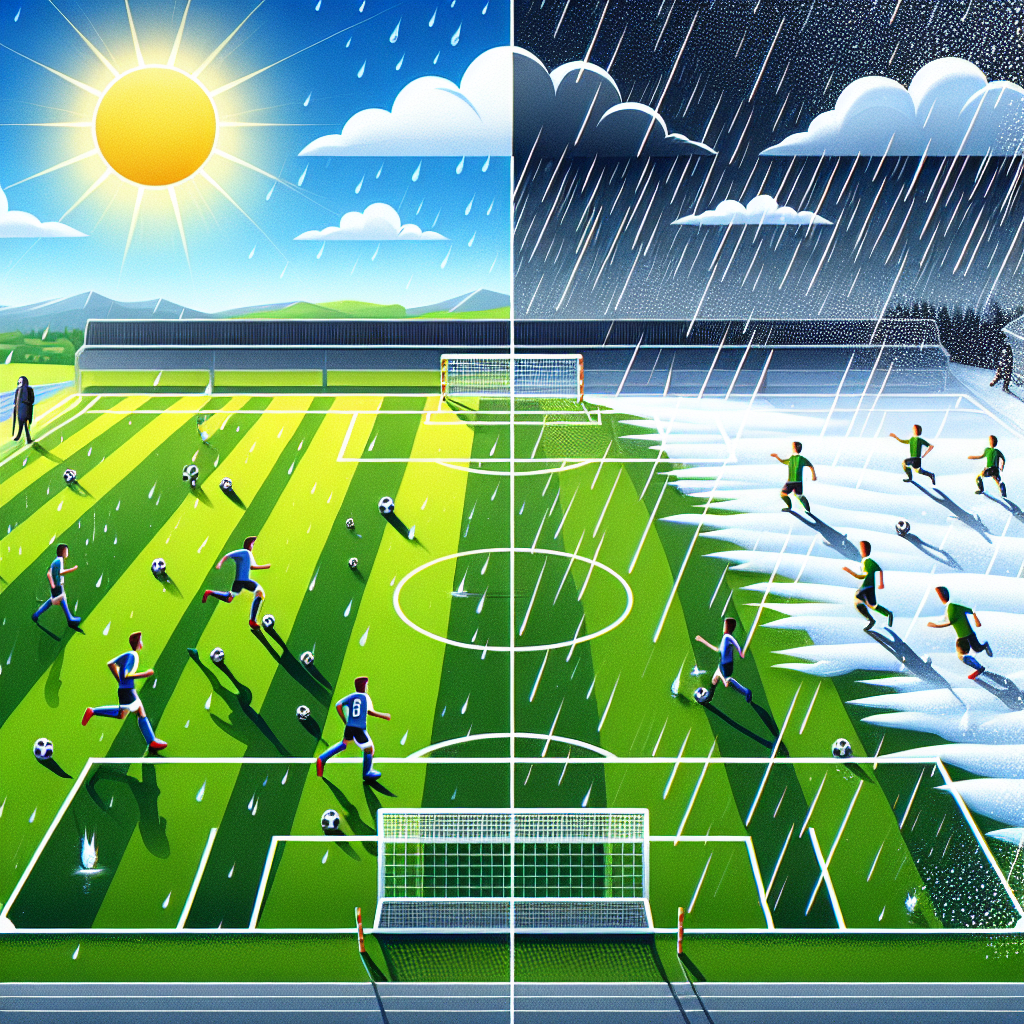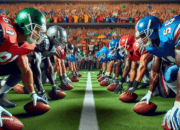Introduction
Weather conditions significantly influence soccer game scores, affecting player performance, strategy, and the overall dynamics of the match. For enthusiasts of the sport, understanding how factors like temperature, humidity, and wind can shape the outcome of a game is essential. This knowledge allows fans, coaches, and athletes alike to better prepare and adjust to varying environmental conditions. In this article, we will explore the various ways weather impacts soccer game scores, detailing the specific elements that contribute to the game’s outcome.
How Temperature Affects Soccer Game Scores
Temperature plays a critical role in determining the pace and intensity of a soccer match. When the temperature is too high, players may experience fatigue more quickly, which can lead to decreased performance and lower goal output. High temperatures can cause dehydration and muscle cramps, slowing down player movements and reducing their ability to execute plays efficiently. For instance, a study from 2022 found that matches played in temperatures exceeding 30°C (86°F) saw an average of 15% fewer goals compared to matches played in cooler conditions. This statistic underscores the significant impact that thermal stress can have on the players’ energy levels and overall performance.
Conversely, cold weather can also hinder scoring opportunities on the field. While players may be more agile in cooler temperatures, icy conditions can lead to poorly executed passes and slips, affecting ball control. Heavy jackets and thermal gear might restrict movement, leading to less agile play. Additionally, the chilling effect can cause muscle tightness, resulting in a higher chance of injury. Reports from the 2024 season indicated that matches played in extreme cold (below 0°C or 32°F) had a noticeable drop in scoring, with only 2.5 goals scored on average per match, compared to 3.4 goals in moderate climates.
The Impact of Humidity on Soccer Performance
Humidity affects soccer game scores by influencing player stamina and hydration. High humidity levels make it difficult for players to regulate body temperature, causing the body to tire much faster. This leads to reduced endurance, which can limit a team’s ability to press for additional goals as the match progresses. In contrast, a low-humidity environment can enhance player performance, allowing for quicker movements and sharper decision-making. According to a report from the 2025 soccer season, matches played under high humidity conditions saw a decrease in goals scored by roughly 20% because players could not maintain their usual intensity throughout the game due to exhaustion.
Additionally, humidity can directly impact the ball’s behavior on the field. In damp conditions, the ball may travel differently on the pitch, which can affect players’ passing accuracy and shooting technique. For example, significantly humid weather can make the pitch slicker, causing passes to slide further than intended, thus disrupting the rhythmic flow of the game. Teams accustomed to playing in dry conditions might struggle to adapt, leading to unpredictable outcomes in their performance and a lower total score during the match.
The Role of Wind in Soccer Game Outcomes
Wind can dramatically influence soccer game scores by altering the trajectory and distance of the ball. When strong winds are present, players may struggle with passing and shooting accuracy. A gust can push a ball off course or make it harder to control during a game. Teams need to adapt their strategies based on wind conditions, often leading to conservative play styles that avoid long-range shots or risky passes. Consequently, games played in areas known for high winds, such as coastal stadiums, often exhibit fewer goals. In fact, statistics from the 2024 season revealed that matches played in windy conditions saw an average scoring rate decline of 15% compared to games with calm winds.
Moreover, the tactical nuances introduced by wind can affect team formations during the game. Coaches often change strategies to account for adverse wind conditions; for example, they may instruct players to focus on short passes and maintain possession rather than pushing for aggressive forward plays. Such adjustments can lead to a more defensive style of play, which inherently limits goal-scoring opportunities. Furthermore, a windy atmosphere can create psychological pressure on athletes, who may second-guess their decisions, leading to less confident play and thereby impacting the final score even more.
Precipitation and Its Effects on Goal Scoring
Rain, snow, or sleet can significantly impact soccer game scores by altering the field conditions and player performance. Wet pitches can lead to a slower game due to increased mud and slick surfaces, making it difficult for players to maintain their footing or execute precise movements. When teams are faced with slippery conditions, the likelihood of unforced errors rises, leading to increased turnovers and fewer goal-scoring opportunities. For instance, during the 2023 season, it was recorded that games played in heavy rain resulted in an average of 30% fewer goals than dry matches, attributable mainly to injuries and missed opportunities.
Moreover, precipitation can affect ball handling and passing. A wet ball becomes heavier, and players need to adjust their kicking technique to account for how it travels. This can lead to missed shots or inaccurate passes, disrupting a team’s rhythm. Additionally, teams that play in regions with habitual precipitation often adapt better to these conditions, which can provide a competitive edge over opponents not accustomed to such weather. Ultimately, weather-related stops, such as delays for heavy rainfall, can also disrupt player focus and momentum, which can lead to lower scores as players may struggle to regain their rhythm.
Psychological Impact of Weather on Soccer Players
The psychological effects of weather are often overlooked when discussing how weather conditions affect soccer game scores. Athletes’ mental preparedness can be altered by external factors like temperature and precipitation. For example, players may feel less motivated to perform well in harsh weather conditions, resulting in a drop in performance levels. A study conducted in late 2024 found that players reported feeling more fatigued and demotivated during matches played in extreme heat or heavy rain, which indirectly influenced their ability to score goals.
Additionally, weather conditions can affect team morale and cohesiveness. If one team is thriving in a particular weather condition while the other is struggling, it could lead to frustration and decreased focus for the underperforming team. This disparity often leads to an even more significant difference in scores, with one team capitalizing on their conditions while the other falters. Moreover, psychological fatigue caused by poor weather conditions can affect decision-making processes in split-second scenarios during critical moments of play that might otherwise lead to scoring opportunities.
The strategic aspect of player substitutions also comes into play in diverse weather conditions. Coaches are compelled to assess both physical capabilities and mental states when deciding which players to substitute based on current weather conditions. This strategic decision-making can also influence goal-scoring potential during the match.
Conclusion
Weather conditions play a pivotal role in determining soccer game scores by influencing player performance, strategy adjustments, and overall team dynamics. Factors such as temperature, humidity, wind, and precipitation not only affect how players physically interact with the game but also alter the psychological aspects of play. Understanding these conditions can give teams and spectators alike insights into the potential outcomes of a match. In an era where analytics play an increasing role in sports, the consideration of weather-related factors is essential for making informed predictions and strategies. As we move further into 2025, the importance of accounting for weather conditions remains clear, proving that even the most skilled players can struggle under less-than-ideal environmental situations.
FAQs
1. How much do weather conditions impact player performance in soccer?
Weather conditions can significantly impact player performance, often leading to reduced stamina and increased risk of injury. For example, high temperatures and humidity levels can cause quicker fatigue, while cold weather may lead to tight muscles and poorer dexterity.
2. Do certain teams perform better in specific weather conditions?
Yes, teams that are accustomed to particular weather patterns tend to perform better in those conditions. Teams from warmer climates may struggle in cold, wet weather and vice versa.
3. How does wind affect a soccer match?
Wind can alter the trajectory and distance of the ball, making passing and shooting more challenging. Strong winds typically lead to conservative play styles, with decreased goal-scoring opportunities.
4. What are the effects of rain on soccer game scores?
Rain can create slick field conditions, slowing down the pace of play and increasing the chance of errors. Historically, matches played in heavy rain see a significant decline in goal scoring.
5. How can teams prepare for adverse weather conditions?
Teams can prepare for adverse weather by adjusting their training to replicate weather conditions, studying strategic gameplay suited for specific environmental elements, and ensuring players are psychologically prepared to adapt to changes on the field.












